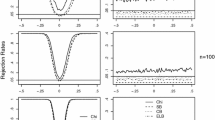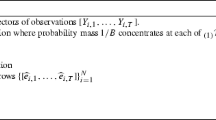Abstract
In the context of the continuously updated generalized-methods-of-moments (GMM), this study evaluates the finite sample properties of Wald- and criterion-based bootstrap inference for a class of models defined by non-linear conditional moment functions. This work provides simulation evidence that validates the moving block-bootstrap (MBB) as an alternative to asymptotic approximation for robust finite sample GMM inference. The study considers data generating processes with highly non-linear conditional moment functions, weak instruments, and near failure of the identification condition. In the absence of a consensus on best practice when identification is weak, Monte Carlo results of this study are encouraging to the empirical researchers. For criterion-based tests, the MBB performs fairly well in reducing the error in the rejection frequency that occurs when first-order asymptotic critical values are used. In particular, it is possible to improve finite sample inference by inverting bootstrap Wald-type statistics which are commonly used in practice The bootstrap percentile-\(t\) confidence intervals performed better than the asymptotic confidence intervals but only marginally in weakly identified specifications with high non-linear moment functions.






Similar content being viewed by others
References
Altonji JG, Segal LM (1996) Small sample bias in GMM estimation of covariance structures. J Bus Econ Stat 14(3):353–366
Andersen TG, Sorenson BE (1996) GMM estimation of a stochastic volatility model: a monte carlo study. J Bus Econ Stat 14(3):328–352
Anderson TW, Rubin H (1949) Estimation of the parameters of a single equation in a complete system of stochastic equations. Ann Math Stat 20:46–63
Andrews DWK (2002) Higher-order improvements of a computationally attractive \(k\)-step bootstrap for extremum estimators. Econometrica 70:119–162
Antoine B, Renault E (2009) Efficient GMM with nearly-weak instruments. Econom J 12:135–171
Bernard J-T, Dufour JM, Khalaf L, Kichian M (2011) An identification-robust test for time-varying parameters in the dynamics of energy prices. J Appl Econ 27(4):603–624
Bond S, Windmeijer F (2005) Reliable inference for GMM estimators? Finite sample properties of alternative test procedures in linear panel data models. Econom Rev 24(1):1–37
Bowsher CG (2002) On testing overidentifying restrictions in dynamic panel data models. Econ Lett 77:211–220
Burnside C, Eichenbaum M (1996) Small sample properties of GMM-based Wald tests. J Bus Econ Stat 14(3):294–308
Caner M (2002) Testing, estimation in GMM and CUE with nearly-weak identification. Econom Rev 29:330–363
Davidson R, MacKinnon J (2000) Bootstrap tests: how many bootstraps? Econom Rev 19:55–68
Davidson R, MacKinnon JG (2002) Fast double bootstrap tests of nonnested linear regression models. Econom Rev 21:417–427
Davidson R, MacKinnon JG (2007) Improving the reliability of bootstrap tests with the fast double bootstrap. Comput Stat Data Anal 51(7):3259–3281
Davidson R, MacKinnon JG (2011) Bootstrap confidence sets with weak instruments. Queen’s Economics Department Working Paper (1278)
Dominguez MA, Lobato IN (2004) Consistent estimation of models defined by conditional moment restrictions. Econometrica 72(5):16011615
Dovonon P, Renault E (2008) GMM overidentification test with first order underidentification. Unpublished Manuscript www4.ncsu.edu/dpellet/tec/renault.pdf
Giacomini R, Politis DN, White H (2013) A warp-speed method for conducting Monte Carlo experiments involving bootstrap estimators. Econom Theory 29(3):567–589
Grant N (2012) Identification from moment conditions with singular variance. Unpublished Manuscript, University of Cambridge. http://www.econ.cam.ac.uk/postgrad/nlg24/pubs/jobmarketfinal1.pdf
Guggenberger P (2005) Monte-Carlo evidence suggesting a no moment problem of the continuous updating estimator. Econom Bull 3(13):1–6
Guggenberger P (2008) Finite sample evidence suggesting a heavy tail problem of the genralized empirical likelihood estimator. Econom Rev 26:526–541
Guggenberger P, Hahn J (2005) Finite sample properties of the \(2-\)step empirical likelihood estimator. Econom Rev 24(3):247–263
Hahn J, Kuersteiner G, Newey W (2003) Higher order properties of bootstrap and jackknife bias corrected maximum likelihood estimators. Working paper, MIT
Hahn J, Hausman J, Kuersteiner G (2004) Estimation with weak instruments: accuracy of higher-order bias and MSE approximations. Econom J 7:272–306
Hall P, Horowitz JL (1996) Bootstrap critical values for tests based on generalized method of moments estimators. Econometrica 64:891–916
Hall P, Horowitz JL, Jing BY (1995) On blocking rules for the bootstrap with dependent data. Biometrika 82:561–574
Hansen LP, Singleton K (1982) Generalized instrumental variables estimation of nonlinear rational expectations models. Econometrica 50(5):1269–1286
Hansen LP, Heaton J, Yaron A (1996) Finite sample properties of some alternative GMM estimators. J Bus Econ Stat 14(3):262–280
Hausman J, Lewis R, Menzel KM, Newey W (2011) Properties of the CUE estimator and a modification with moments. J Econom 165:45–57
Inoue A, Rossi B (2011) Testing for weak identification in possibly nonliner models. J f Econom 161:246–261
Inoue A, Shintani M (2006) Bootstrapping gmm estimators for time series. J Econom 133:531–555
Jun SJ, Pinske J (2012) Testing under weak identification with conditional moment restrictions. Econom Theory 28(6):1229–1282
Kleibergen F (2005) Testing parameters in GMM without assuming that they are identified. Econometrica 73(4):1103–1123
Kleibergen F, Mavroides S (2009) Weak instrument robust tests in GMM and the new keynesian Phillips curve. J Bus Econ Stat 27(3):293–311
Kocherlakota N (1990) On tests of representative consumer asset pricing models. J Monetary Econ 26:285–304
Künsch HR (1989) The Jacknife and the bootstrap for general stationary observations. Ann Stat 17:1217–1241
Lagunes AF (2007) Finite sample evidence of IV estimators under weak instruments. J Appl Econom 22:677–694
Lamarche J-F (2004) The numerical performance of fast bootstrap procedures. Comput Econ 23:379–389
Leger C, Politis DN, Romano JP (1992) Bootstrap technology and applications. Technometrics 34:378–398
Lepage R, Billard L (1992) Exploring the limits of bootstrap. Wiley, New York
Moreira MJ, Porter JR, Suarez GA (2009) Bootstrap validity for the score test when instruments may be weak. J Econom 149:52–64
Newey W, Smith R (2004) Higher order properties of GMM and generalized empirical likelihood estimators. Econometrica 72:219–255
Newey WK, Windmeijer F (2009) Generalized method of moments with many weak moment conditions. Econometrica 77(3):687–719
Ouysse R (2013) A fast double bootstrap procedure for approximating the small-sample bias. Commun Stat Simul Comput 42:1472–1494
Stock JH, Wright JH, Yogo M (2002) A survey of weak instruments and weak identification in generalized method of moments. J Bus Econ Stat 20:518–529
Tauchen G (1986a) Finite state space Markov-Chain approximations to univariate and vector autoregressions. Econ Lett 20:177–181
Tauchen G (1986b) Statistical properties of generalized method-of-moments estimators of structural parameters obtained from financial market data. J Bus Econ Stat 4(4):397–416
Tauchen G, Hussey R (1991) Quadrature-based methods for obtaining approximate solutions to nonlinear asset pricing models. Econometrica 59(2):371–396
Wright HJ (2003) Detecting lack of identification in GMM. Econom Theory 19:322–330
Acknowledgments
I would like to thank two anonymous referees for valuable comments and suggestions that led to substantial improvement of the paper. Special thanks go to the Editor and Co-Editor for their continuous encouragement and comments that improved the final revision.
Author information
Authors and Affiliations
Corresponding author
Appendices
Appendix 1: Martingale differences
This proof is a special case of the general theory and proof developed in Andrews (2002).
Let \(\{g^{*}_{t}\}\), where \(g^{*}_{t}=g^{*}(X_{t},\widehat{\theta })\), be a martingale first difference sequence satisfying
This implies that the matrix \(\widetilde{W}_{n}\) for the non-overlapping blocks reduces to
Plugging \(\widetilde{W}_{n}\) in \(V_{n}\) and using \(W_{n}=\varOmega ^{*}(\widehat{\theta })^{-1}\) leads to
Let \(\widehat{M}_{n}=I_{m\times q}-\widehat{P}_{n}\) where\(\widehat{P}_{n}=\widehat{\varOmega }_{n}^{-\frac{1}{2}}\widehat{G}_{n} [\widehat{G}_{n}^{\prime }\widehat{\varOmega }_{n}^{-1}\widehat{G}_{n}]^{-1} \widehat{G}_{n}^{\prime }\widehat{\varOmega }_{n}^{-\frac{1}{2}}. \widehat{P}_{n}\) is an idempotent matrix, that is \(\widehat{P}_{n}=\widehat{P}_{n}'\) and \(\widehat{P}_{n}=\widehat{P}_{n}\widehat{P}_{n}\).Therefore,
Appendix 2: Quadrature approximation
The following is a description of the quadrature approximation as outlined in Tauchen (1986a), Tauchen and Hussey (1991) and Kocherlakota (1990). See these references for further details about these derivations.
The Euler equation for the calibrated economy can be written in terms of prices and dividends,
where we denote by \(d_{t}=\frac{D_{t}}{D_{t-1}}\) the dividend growth, \(v_{t}=\frac{P_{t}}{D_{t}}\) the price-dividend ratio and \(c_{t}=\frac{C_{t+1}}{C_{t}}\) the consumption growth.
Our economy is similar to the one described by Kocherlakota (1990) with three assets: the Risk free \(R_{f}\) which pays one unit of consumption, the market portfolio \(MP\) which pays \(C_{t}\) in period \(t\) and the stock market \(SM\) with dividend pay-offs \(D_{t}\) in period \(t\). Equation (28) implies a conditional moment restriction for each asset \(j\in \{MP,SM,R_{f}\}\).
The only driving random processes in the model are \(c_{t}\) and \(d_{t}\), and so, conditional on the past, \(P_{t}\), or equivalently, \(v_{t}\) is a deterministic function of \(c_{t}\) and \(d_{t}\) implicitly given by the Euler equation (28).
The deterministic function that gives \(v_{t}\) as a solution to (28) cannot be found in closed analytic form. The quadrature approximation uses a finite state Markov process to approximate the bivariate vector autoregression, and enables the approximate solution to be obtained by matrix inversion.
The approximation involves fitting a 8 state Markov chain to log consumption growth and log dividend growth calibrated so as to approximate the first order VAR in (25).
Let \(\widetilde{c}(l)\) and \(\widetilde{d}(l),\,l=1,\ldots ,16,\) denote the abscissa for the \(8-point\) quadrature rule. Each combination of abscissa \(\{(k,k'), k=1,\ldots ,8; k'=1,\ldots ,8\}\) defines a state \(s_{j}\), for \(j=1,\ldots ,\widetilde{N}\), where \(\widetilde{N}=8^{2}\). Let \(\widetilde{c}_{s_{j}}\) and \(\widetilde{d}_{s_{j}}\) denote the values of \(c\) and \(d\) in state \(s_{j}\) and let \(\widetilde{Y}_{s_{j}}=(\widetilde{c}_{s_{j}},\widetilde{d}_{s_{j}})\).
The transition matrix \(Pi\) for the Markov process defined by \(Pi_{k,j}=P\left( Y_{t+1}=\widetilde{y}_{s_{j}}|\right. \) \(\left. Y_{t}=\widetilde{y}_{s_{k}}\right) \) where,
where \(S(x)=\sum _{l=1}^{\widetilde{N}}\frac{p(\widetilde{y}_{s_{l}}|x)}{p(\widetilde{y}_{s_{l}})}w_{l}\). The Gaussian rule defines \(p(x|\widetilde{y}_{s_{k}})\) and \(p(x)\) as density functions for the bi-variate normals \(N(\widetilde{y}_{s_{k}},\Sigma )\) and \(N({\varvec{\mu }},\Sigma _{Y})\), respectively, where \(\Sigma _{Y}\) solves \(\Sigma _{Y}=\varPhi \Sigma _{Y}\varPhi '+\Sigma \). The weights \(w_{j}\) are computed using a Hermite Gauss rule.
The solution to the integral in the Euler equation (28) is characterized by the solution to the system of \(\widetilde{N}\) linear equations given by the discrete approximation in
The solution exists if all the eigenvalues of the \(\widetilde{N}\times \widetilde{N}\) matrix \({{\fancyscript{S}}}\) defined by the elements \({{\fancyscript{S}}}_{k,j}=\beta \Pi _{k,j}(\widetilde{c}_{s_{j}})^{-\gamma } \widetilde{d}_{s_{j}}\) lie within the unit circle. The solution is characterized by,
where \({\iota }_{\widetilde{N}}\) is a \(\widetilde{N}\times 1\) column vector of ones. For the market portfolio, the dividend ratio is equal to \(\widetilde{d}_{MP,s_{j}}=\widetilde{c}_{s_{j}}\) and therefore \({{\fancyscript{S}}}_{k,j}=\beta \Pi _{k,j}(\widetilde{c}_{s_{j}})^{1-\gamma }\). From the series of the equilibrium price-dividend ratios \(\widetilde{v}_{i}, i\in \{F,MP,SM\}\), the corresponding returns are computed as:
Rights and permissions
About this article
Cite this article
Ouysse, R. On the performance of block-bootstrap continuously updated GMM for a class of non-linear conditional moment models. Comput Stat 29, 233–261 (2014). https://doi.org/10.1007/s00180-013-0447-0
Received:
Accepted:
Published:
Issue Date:
DOI: https://doi.org/10.1007/s00180-013-0447-0




